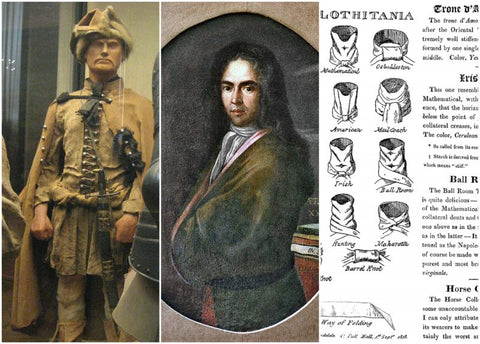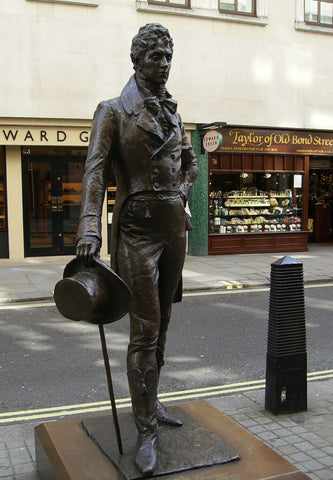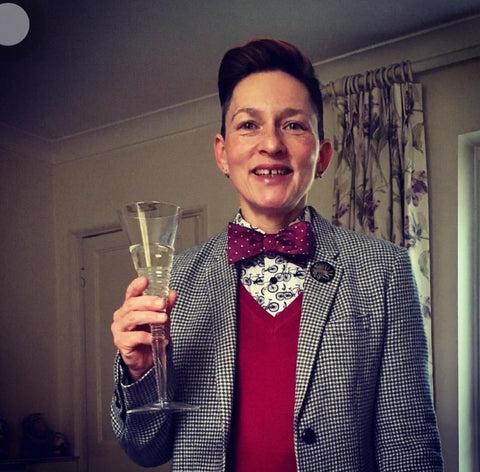
Croatians, Beau Brummell, Churchill & Hipsters: The History of the Bow Tie
By Beth Kennedy

Love them or hate them, bow ties have literally been around for centuries. And, just as I suspected, they’ve had a very colourful history so far!
The French Bow Tie Revolution
One day King Louis XIV of France was chilling with some Croatian soldiers and he loved the ‘scarves’ they were wearing.
The scarves were a very early version of the bow tie. As a staple of the Croatian Army’s uniform during the 16th and 17th centuries, the early bow tie was called a “cravate” - literally old-French for “Croatian”! Of course, we now know a cravat as a type of necktie and not a resident of the beautiful south-eastern European country.
The Croatian soldiers used their cravates to tie their shirts together. So it was more of a practical thing than a fashion statement. But, the French have always been famously chic, so it didn’t take long for the upper classes to adapt the cravats for aesthetic purposes. Coco Chanel wasn’t around back then, so it was up to the rich people to play around with style ideas.

The very fact the cravat was a practical military item transformed into an avant-garde decorative statement, reminds me of when emos started to wear military jackets in the noughties because of My Chemical Romance. History really does repeat itself!
I particularly love this wry comment about the fashion-conscious upper classes a couple of hundred years later:
“[...]when starched linen cravats were worn, perfection in the art of tying them was one of the great accomplishments of a dandy.”
- Century Dictionary, 1897
Cravats were made of linen and lace, though silk was starting to become very popular in the late 1600s. Europe already had access to the Silk Road, but it wasn’t until around 1685 that the UK had a proper look-in when it came to silk. King Louis XIV had revoked the Edict of Nantes, which meant the Protestants couldn’t practice their religion freely in France any more. As a result, thousands of French Protestants moved to other countries in Europe. A lot of the silk weavers from Lyons ended up in Spitalfields, London. They brought new techniques and high quality materials...so clothing such as cravats was made from the finest silks.
The birth of the suit and tie
By the turn of the 18th century, George Bryan Brummell, better known as Beau Brummell, appeared on the scene.
The middle-class dandy aspired to be an upper class gentleman - something his dad had instilled in him from a young age. Beau essentially became one of Britain’s first reality TV stars before TV was invented (I was trying to work out what the male equivalent of an “It girl” is!). The Prince Regent noticed him and, in true Louis XIV style, loved his eccentric fashions.
There’s an awesome statue of Beau on Jermyn Street in London - he’s rather fittingly facing the Piccadilly Arcade...an emporium of suit tailors, grooming products, luxury watches and so on.

Even though Beau later died penniless in 1845, he had such a massive influence on fashion and expressing ourselves through what we wear. He was the trailblazer who effectively told us “Hey, it’s OK if you’re poor - you can still wear clothes that reflect your personality.”
After all, those of you who love musicals may remember a line from the song “Bustopher Jones: The Cat About Town” in Cats: “In the whole of St. James's the smartest of names / Is the name of this Brummell of cats.”
References to Beau even made it over to the Atlantic. In “You’re Never Fully Dressed Without a Smile” from Annie the girls sing “Your clothes may be / Beau Brummell-y / They stand out a mile!”
So, why am I going on about ol’ Beau? He is actually the grandfather of matching the bespoke-fitting full-length trouser suit with a bow tie. He didn’t like the ideas of stockings and breeches - instead choosing formal trousers as we know them today and matching jackets. And, voila, the suit was born!
Doctor’s orders
In the late 1800s and early 1900s the bow tie became synonymous with academics...especially surgeons and doctors! Again, bow ties were used as a practical alternative to neck ties, as they didn’t get in the way when dealing with patients. Bow ties were also said to be more hygienic as they were up high and out of the way from all the bodily fluids humans tend to produce.
There’s also the socio-economic aspect too. Bow ties were seen as a dapper but democratic option (it’s class-friendly). This made the bow tie ideal for doctors and professors dealing with people from all walks of life! Again, this goes back to Beau Brummell. He wanted to do away with aristocratic finery and make fashion more accessible for all....so the bow tie was seen as the more approachable choice.
By the roaring 1920s, dapper dandies were back in fashion! Bow ties were available in loud patterns and vibrant colours such as red, purple and yellow. The first Oscars ceremony was in 1929...and you bet there were lots of black and white bow ties on the red carpet!
Churchill’s bow tie
Winston Churchill, prime minister of Britain from 1940 - 1945, wore the iconic navy blue and white polka dot bow tie throughout his first term as the country’s leader. It’s said the look was so popular that he more or less directly inspired the mass production of the Blenheim bow tie!

Unfortunately, by the late 1940s, bow ties had disappeared in favour of big, bold-coloured ties. As we approached the 1950s, people wanted to express themselves more. After World War II rationing ended, the economy boomed and people had more disposable income. Clothes became more colourful, but bow ties were resigned to work uniforms (still popular with doctors and professors, of course!).
Love and marriage in the 60s and 70s
When we think of the sixties, we usually think of those ultra-slim ties and fitted suits (they still look super modern today!). Bow ties, however, were still a popular choice at weddings - especially the straight-edge batwing bow ties or the skinny diamond tip bow ties.
The seventies, however, saw the popularity of kipper ties and cravats rise. People would wear them for work and the latter as casual wear. The decade was all about big pointy collars and equally big snapper butterfly bow ties. Again, bow ties were very popular when it came to wedding attire.
Those damn hipsters
By the late 00s, it was hip to be square, as the famous song goes. The uniform of choice for hipsters was a pair of thick-rimmed glasses (or Shutter Shades if you were on a night out), a checked shirt, cardigan, skinny jeans, Converse and a bow tie. Preppy geek-chic was in. But by the mid 2010s, the resurgence of the grungy look was well underway - so bow ties took a backseat for a little bit.

Now
Skip forward to now and there’s three different types of bow tie: self-tie, pre-tied and clip-on. This doesn’t include the various styles of bow tie such as the butterfly, slim diamond point and the batwing.
But most importantly, the bow tie has become an accessory for everyone. No matter what your age, gender, race or sexuality - the bow tie is universal. Shiloh Pitt, Idris Elba, Diane Keaton, Tom Daley, Beyonce, Ellen Page - they all look good in a bow tie. I can’t think of anyone who doesn’t look good in a bow tie.

GFW Customer Sarah
Check out GFW Clothing Bow Ties
Shop now
